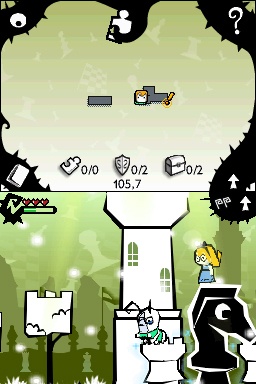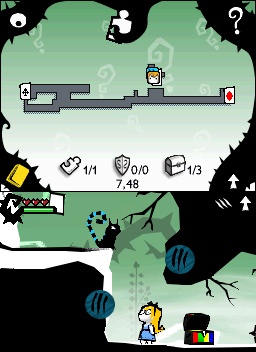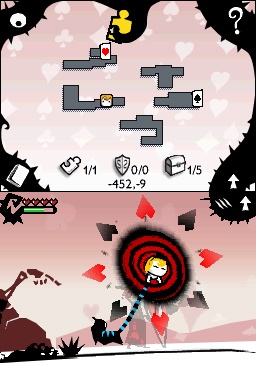There can't be too many examples of a movie-licensed handheld video game causing much of a stir, but Alice in Wonderland on the DS is an exception to the rule. By weaving elegantly layered puzzles with a striking childlike visual signature, French studio Etranges Libellules has crafted one of the most charming games to hit Nintendo's handheld in a long time. Much of the game's beauty lies in its refined simplicity, in terms of both its adorable aesthetics and the layered approach to the level and puzzle design, which rewards patiently reexploring the map as you unlock new skills. Right from the moment the wide-eyed Alice cheerfully bounds through one of the doors on the game's menu screen, there's an infectious playfulness that runs through every element.

Having suffered the misfortune of falling down a rabbit hole (again), Alice finds herself joined in the fantasy realm of Underland by a growing posse of anthropomorphic accomplices with special powers. With the evil Red Queen and the slavering Jabberwocky to ultimately kick against, Alice and the mighty animal collective decide the best course of action is to seek out the mighty Vorpal Sword and put a stop to the nonsense. In doing so, however, you don't control Alice herself, but must instead carefully marshal a four-strong team of weird and wonderful animals, each armed with a flexible array of skills that help shape and manipulate the surreal environment to your whims. Via an intuitive touch-screen interface you can instantly switch between McTwisp the white rabbit, Absolem the giant caterpillar, Chessur the grinning Cheshire Cat, and, eventually, the gleefully unhinged Mad Hatter.
As you traverse the irresistibly gorgeous two-dimensional landscape, you encounter a series of context-sensitive challenges and obstacles that can be overcome only by using specific characters. For example, using McTwisp's time-manipulating powers allows you to fashion a makeshift bridge out of plant roots by accelerating time, while Absolem's curious gravity-flipping ability lets you stride across a ceiling to avoid an otherwise impassable area. Later, once you meet up with the full crew, you also gain Chessur's ability to make objects appear or disappear and the Mad Hatter's cunning world-flipping skill. And if that weren't enough, every character also gains secondary skills as you venture deeper into the adventure, such as Chessur's nimble wall-jumping ability or McTwisp's double-jump. Far from overwhelming you with abilities, the game gradually layers new skills on you in such a way that by the time you're confident in how to use them, a problem arrives to test your mettle.

Part of the game's appeal is the satisfying nature of the exploration, with many hidden chests tucked away for the patient traveller to uncover. DSi owners even have the benefit of puzzles that challenge you to quickly find items that match the colour of the chest within a time limit, sending you frantically scrabbling around in real life trying to point the outer camera of the console at an appropriate object to unlock the goodies that lie tantalisingly within. Most of these goodies are collectible pictures, but you can also gain extra powers or permanent health upgrades, and the allure of returning to areas previously off-limits in search of hidden chests is strong.
Another of Alice in Wonderland's cunning ideas is the way it lets you fashion new routes and shortcuts by retrieving jigsaw pieces. Rather than force you to slog your way from one end of the map to the other to get back to a previous section, you can freely manipulate the individual pieces of the game's map screen as you see fit. Eventually, you even gain the ability to teleport around the environment at will, making the task of backtracking far less of a chore than it may otherwise have been. That said, there are occasions when you feel slightly cut adrift from what the game wants from you, often traversing cluelessly in the wrong direction before it becomes apparent that you've stumbled off track. With just a little more gentle signposting, such periods of time-wasting frustration could have been averted.

The relentlessly repetitive combat also blunts the enjoyment at times. You repeatedly have to fend off the attentions of a respawning army of Red Knights sent by the evil Red Queen to thwart your progress. Appearing at regular intervals through a portal, these bizarre enemies will try to rip Alice asunder if you neglect her for longer than a few seconds, but dealing with them proves to be less enjoyable than it might be. Despite the ability to unlock new combat moves for each character, dealing with this surreal army of playing cards requires little more than a basic combination of frantic taps and swipes to fend them off. The most demanding enemies might require blocking or rolling behind them first, but for the most part, the combat is predictable, and its repetitive nature gradually chips away at your appreciation of an otherwise entertaining experience.
But even when the game threatens to tarnish your enjoyment, you can always rely on a delightful spark of creativity to put a smile back on your face. Whether it's a moment of puzzle genius, a deft animation sequence, or simply a sharp one-liner, there's something to admire every step of the way. Alice in Wonderland isn't simply an admirable attempt at adapting a licensed property for a video game, but a great video game in its own right. By skilfully blending wonderfully creative puzzle elements into a beautiful fantasy world, it manages to not merely do justice to the source material but build upon it in a way that only video games have the capacity to do.